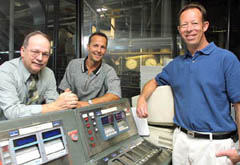 |
| Teams headed by Henri Major, Philippe St-Pierre and Mario Boileau helped restore power and oversaw energy consumption on campus in the aftermath of the blackout. |
Daniel Morin
On August 14 at 4:15 p.m., the heart of the campus stopped beating. This is how Philippe St-Pierre, supervisor of electrical systems, described what happened at the University of Ottawa when the largest blackout in North American history hit Ontario and the northeastern United States.
"The power station is what makes the heart of the campus beat," says Henri Major, chief operating engineer for the thermal power station. On that day, except for one pump and an emergency generator, everything stopped dead. A sudden silence, punctuated only by the ringing of telephones, replaced the rhythmical, deafening rumble of the machines that pump out heat and cool air, and feed electricity and water to most of the buildings on campus. Never in his 33 years of service at the University had Major seen anything like it.
A catastrophe indeed, and one that certainly gave rise to ingenious deeds and opportunities to pull together during the hours and days that followed. The director of Physical Resources Service, Mario Bouchard, was not remiss in emphasizing in a memorandum to his staff: "The quick reaction to the breakdown and the management of energy consumption were made possible, thanks to the excellent work of maintenance and operational crews and the collaboration of the campus community." Rector Gilles Patry added his own thanks to the physical resources and protection services teams for their "altogether extraordinary work."
Several employees, including Mario Boileau, a mechanical supervisor with Physical Resources Service who was on vacation at the time, returned to work to assist. Some offered their services without even being called, says St-Pierre.
Major, Boileau and St-Pierre appreciate the effort put in by their respective teams.
Quick intervention by the various crews prevented more serious consequences. For example, walk-in coolers in Roger Guindon Hall contain specimens whose loss could have irretrievably compromised the work of many researchers. Fuel oil had to be found to keep the emergency generator operating. If necessary, fuel could have been removed from a 180,000-litre fuel tank on campus and sent to Roger Guindon.
Although the power came back on several hours later (about 1:30 a.m. on Friday), it was nevertheless necessary to work out various procedures with everyone to insure a smooth start-up of all systems and equipment. It takes about eight hours to complete these tasks, Boileau explains.
During the days following the blackout, power station crews were able "to count on an extraordinary co-operation" from campus community to reduce energy consumption as requested by Hydro One. During the entire week of August 19-24, energy consumption was maintained at about 6,000 kilowatt-hours, compared to a normal 9,000-plus during the summer months.
Some solutions were simple, yet ingenious. The power to pop machines was cut, for example. And buildings were cooled at night by purging the indoor air and replacing it with fresh outdoor air. Dog days for staff indeed, but this process took advantage of the coolness of the night to reduce temperatures in offices for a good part of the following day.
Employees were also encouraged to limit use of air conditioners, computers, printers, photocopiers and other equipment.
The University was also able to use a natural gas-powered generator capable of producing 600 kilowatt-hours, and a steam-operated absorption chiller, which provided cooling while using very little electricity.
Major pointed out that the University had to remain open that week, because it was exam time for summer semester students.
According to Michael Histed, director of the Environmental Health and Safety Service, the power outage proved to be "a good learning experience for the University. It’s going to allow us to review our contingency plans."